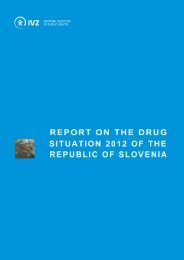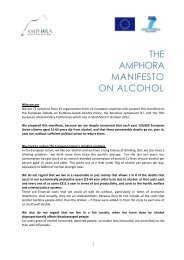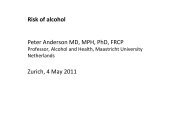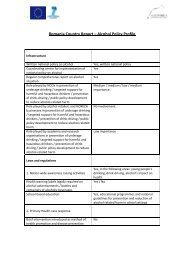Interpretations of Individualistic and Collectivistic ... - CSCanada
Interpretations of Individualistic and Collectivistic ... - CSCanada
Interpretations of Individualistic and Collectivistic ... - CSCanada
You also want an ePaper? Increase the reach of your titles
YUMPU automatically turns print PDFs into web optimized ePapers that Google loves.
Hellman M.,Gosselt J. F.,Pietruszka. M.,Rol<strong>and</strong>o S.,Rossetti S.,Wothge J.<br />
/Cross-cultural Communication Vol.6 No.4, 2010<br />
PROCESS AND METHODS<br />
The Reception Analytical Group Interview (RAGI) consists <strong>of</strong> focus group interviews with stimulus texts.<br />
The aim is to gain as much naturally occurring speech as possible <strong>and</strong> to systematize analyses for<br />
cross-country comparisons. The group discussions are oriented around specific predetermined topics<br />
formulated in an open-ended manner. By analysing the speech around the clips, the researcher will learn<br />
how the group members perceive the messages, how they frame them <strong>and</strong> what they know about the things<br />
they see. The researcher identifies <strong>and</strong> codes the participants’ speech modalities.<br />
In view <strong>of</strong> our theoretical model in figure 1 the RAGI tool box is particularly helpful for our inquiries. It<br />
facilitates many dimensions for investigations: (i) exegetical meaning represented by verbal interpretations<br />
<strong>of</strong> symbols by the informants (our data sets); (ii) operational meaning represented by actual symbol use by<br />
the advertiser (<strong>and</strong> informants) as observed by the researcher (the semiotic reading), <strong>and</strong>, additionally, (iii)<br />
positional meaning by interpretations <strong>of</strong> the relationships between symbols <strong>and</strong> their meanings <strong>and</strong> uses<br />
(the analysis <strong>of</strong> the reasoning around the ads in relation to the semiotic reading) (see Mick, 1986: 207 for<br />
these dimensions in consumer research <strong>and</strong> semiotics).<br />
In each country, the material was gathered by 1–2 researchers. They interviewed the adolescents in<br />
sessions that lasted approximately 45 minutes depending on how talkative the groups were. Finl<strong>and</strong> had the<br />
shortest session which lasted with 25 minutes, while one <strong>of</strong> the Polish session lasted as long as around 90<br />
minutes. Four commercials were shown, <strong>and</strong> after each commercial, the participants were invited to have<br />
free group discussions about the following topics: 1) What is happening in the commercial? 2) What has<br />
happened just before the clip? 3) What will happen after the clip? 4) How is drinking portrayed? 5)<br />
Location <strong>and</strong> situation <strong>of</strong> the clip.<br />
The researcher introduced the topics both verbally <strong>and</strong> on a sheet <strong>of</strong> paper placed in front <strong>of</strong> each group<br />
member. We wanted the group to work together to assure that the topics were all addressed during the<br />
discussions. However, with participants <strong>of</strong> this age it proved almost impossible not to interfere at all, or at<br />
least a bit. The interview sessions were audio <strong>and</strong>/or video recorded. Group members remained anonymous<br />
throughout the interview process, identified by number plates only.<br />
The discussions were transcribed <strong>and</strong> the material grouped similarly in all countries. The Finnish team<br />
suggested ways <strong>of</strong> grouping the data based on the Finnish material. All country partners came back with<br />
feedback on how well these worked with their own material. After two such feedback rounds a h<strong>and</strong>book<br />
for coding was developed <strong>and</strong> distributed. The partners then submitted the translated coded materials to the<br />
project coordinator for comparison. Comparisons were commented on <strong>and</strong> finally approved by the partners,<br />
who were most acquainted with their own material.<br />
This paper does not attempt a full analysis <strong>of</strong> the data. Instead, we shall focus on the speech on drinking<br />
generated by two <strong>of</strong> the commercials, examining speech that concerns a) drinking competences related to<br />
amounts <strong>of</strong> alcohol consumed <strong>and</strong> b) outcomes <strong>of</strong> drinking, mostly those expressed as positive. The<br />
perceptions expressed by the adolescents were juxtaposed to the significations <strong>of</strong> drinking that we<br />
interpreted as those aimed at by the advertisers. A brief account <strong>of</strong> the semiotic reading is presented in the<br />
next section.<br />
Ethical considerations. The research had ethical considerations related to the participants’ age, nature<br />
<strong>of</strong> the material, stimulus texts <strong>and</strong> the way in which the material was collected. Informed consent was<br />
adapted. All participants were able to leave the study at any time. The data was rendered anonymous <strong>and</strong><br />
kept in a safe way. The reporting does not leave out information that could unveil the identity <strong>of</strong> the<br />
participants. All <strong>of</strong> the ethical aspects above are included in the systems that the partner institutions have in<br />
place to ensure that questions <strong>of</strong> ethics are considered in every stage <strong>of</strong> the research. The partnering<br />
countries emphasize ethical considerations somewhat differently in the individual procedures for<br />
permissions to conduct interviews in schools.<br />
9 All in all four beer commercials were used as stimulus texts during the group diuscussions.<br />
45









